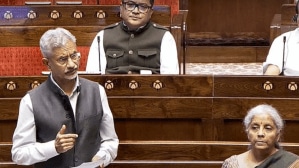Water grid, river linking projects back on Fadnavis’s agenda to tackle drought, regional water dispute
All these projects which were conceptualised in his first tenure as CM in 2014 has remained on paper for past 10 years.
 Last week, Fadnavis during an event in Mumbai said, “The water grid and river linking projects will go a long way towards drought mitigation and also put an end to inter-region disputes over water-sharing (Express Archives)
Last week, Fadnavis during an event in Mumbai said, “The water grid and river linking projects will go a long way towards drought mitigation and also put an end to inter-region disputes over water-sharing (Express Archives)In a step towards tackling the drought in backward Vidarbha, Marathwada and parts of North Maharashtra region, Chief Minister Devendra Fadnavis has brought back two ambitious river-linking projects–Nalganga Wainganga and Nar- Par-Girna on his table. Also back on the agenda is Marathwada water grid project.
All these projects which were conceptualised in his first tenure as CM in 2014 has remained on paper for past 10 years. With absolute mandate to Mahayuti in 2024 Assembly elections, Fadnavis has renewed his pledge to take water grid and two river linking projects to its logical end.
Highly placed sources in Water Resources Ministry said, “Among the list of projects chalked out to make Maharashtra drought-free, Nalganga-Wainganga and Nar-Par-Girna and Marathwada Water Grid have taken the highest priority. And all set to be fast-tracked.”
Last week, Fadnavis during an event in Mumbai said, “The water grid and river linking projects will go a long way towards drought mitigation and also put an end to inter-region disputes over water-sharing. In that sense, Nalganga-Wainganga and Nar-Par-Girna river linking projects will not only help farmers access to water and enhanced irrigated land for agriculture activities but also address long-pending social discord between Marathwada and North Maharashtra arising due to water crisis within regions in Maharashtra.”
The recurring drought in the state has led the state to reflect on multiple projects, both short and long-term. In 2014, Fadnavis had launched Jalyukta Shivar Abhiyan, shortlisting 25,000 villages in Marathwada region which were among the worst hit by drought. It was believed through water conservation schemes that these villages would not only override the crisis but gradually become water self-reliant. However, these schemes required sustained maintenance and monitoring to accomplish the targets.
In 2019, Maha Vikas Aghadi led by CM Uddhav Thackeray had discontinued Jalyukta Shivar. With Eknath Shinde-led Mahayuti government back in power in 2022-24, Jalyukta Shivar was revived. Fadnavis has indicated that Jalyukta Shivar with further modifications will be undertaken during his regime 2024-2029. The scheme, which elicited public support initially in 2014-2019, led to infrastructure related to water structures coming up in large numbers. According to government data, “The Jalyukta Shivar Abhiyan first phase covered 22,593 villages with 6.32 lakh works.”
It led to 27 TMC water storage and helped irrigation in 39 lakh hectares. Yet, it also invited CAG strictures in 2022 for some discrepancies due to substandard works in a few projects. The CAG report based on surveys in 120 villages pointed to alleged lack of transparency and monitoring in schemes leading to shoddy work.
Along with ongoing water conservation schemes, state government believes the water linking projects were the way forward to long-term solutions on water crisis. Basically, it entails diverting surplus water from one river basin to drought-prone region using advanced technology. The state government has given in-principle nod for the two river linking schemes Nalganga-Wainganga and Nar-Par-Girna. These schemes, once completed, promises to tackle drought issues in Marathwada and Vidarbha regions.
While all eight districts in Marathwada region are drought-prone, Vidarbha faces frequent drought situation in five or of eleven districts in western Vidarbha.
Under the Marathwada water grid project, eleven major dams in the region would be interconnected through pipelines to create a network.
The water from surplus dams would be pumped to those reeling under scarcity in lower reservoirs. It indents to cover 12,000 villages across 79 talukas and 79 towns across Marathwada. With Rs 40,000 crore expenditure, water grid is a highly ambitious project which will interconnect Jayakwadi dam (Aurangabad), Yeldhari (Parbhani), Siddheshwar (Hingoli), Majalgsom and Manjara (Beed), Lower Terna, and Sine Kolegaon (Osmanabad) and Dhanegaom (Latur).
The Nar-Par-Girna river linking projects entails 10.64 TMC surplus water transfer to drought-prone parts of Nashik and Jalgaon districts. The project, estimated at Rs 7,015 crore, will irrigate 53,626 hectares in Nashik, 38,304 hectares in Jalgaon and 3,830 hectares Aurangabad.
Whereas Rs 87,000 crore Wainganga-Nalganga river linking project would ensure lifting of water from Gosikhurd dam on river Wainganga in Bhandara district and channelling it to Nalganga in Buldhana district through 427-km long network through canals, left irrigation and pipelines.












